This post is part of a “Shure Week” (August 6-13) series celebrating the release of the new MOTIV line of USB and iOS microphones and interfaces. Check with us through the week to learn more about Shure!
Nine Things You Might Not Know About Shure
Shure has been making microphones for over 90 years. While some of Shure’s legendary products — like the SM57 and SM58 mics — haven’t changed in decades, Shure engineers are always hard at work designing, building and testing new products. One example is the new Shure MOTIV series — which includes the Shure MV5, MV51, MV88, and MVL microphones, plus the MVi audio interface.
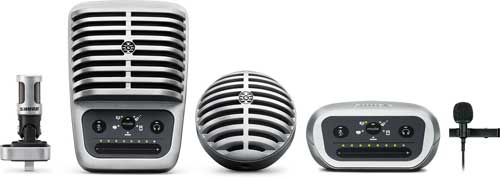
The Shure MOTIV family: MV88 stereo iOS mic, MV51 USB/iOS large-diaphragm condenser, MV5 USB/iOS condenser, MVi USB/iOS audio interface, and MVL lav microphone.
I sat down with Shure Product Specialist Soren Pedersen and Senior Mechanical Engineer Andres Huertas to get the story behind the MOTIV microphones that they helped design. Read on to learn how the MOTIV series drew inspiration from vintage mics like the Shure Model 51, how Sweden’s Gothenburg Symphony Orchestra is using the MV88 to capture concerts, the differences between the MV5 and MV51 microphones, and much more.
zZ: To start out, what exactly is your title at Shure?
Soren: I am a Product Specialist in our Product Marketing group. My role is to be the go-between between the engineering side and the marketing and sales team. We write the requirements: we’ll go to Andres and say, “We need a small condenser with a couple DSP modes, and it’s got to be about this big.” We’ll work with him and develop a concept, and then sit with him throughout the whole engineering process, and consult on the design. It’s really fun for me because I grew up as an “audio nerd” customer, so it’s very natural for me to say, “This guy’s going to want this; it should be this way” type of stuff. We have this killer engineering team that can do anything we ask, so it’s a pretty fun job for me.
zZ: So, Soren, your team — you’re the one pitching new ideas?
Soren: It sort of gets handed down to me from directors and higher-level people saying, “We need better USB mics.” And then it’s my job to write the specifics on it — to come up with the concept, dive into the competitive scene, figure out where we should be price-wise, incorporate all the business needs into that, and roll all that up into a document that’s the kickstarting point of the project team — where we did the whole MOTIV line.
zZ: And then Andres, do you have the task of designing something within those specific requirements?
Andres: Yes. I’m a Senior Mechanical Engineer here. I came in knowing rough sketches of what we’re looking at, working really closely with our ID (Industrial Design) team to leverage a lot of the style they were looking to get out of the line in general, which for the MOTIV products — and for all products — is really important.
“What we really wanted to do with the MOTIV line is roll in this great history that Shure has…we wanted these to reek of Shure vintage. Not just be of some retro-looking thing, but be inspired by specific Shure vintage models that we think people know and love.”
Soren: My first step after we get that document of requirements approved, is to work with the Industrial Designers we have in-house here, which is a super-talented small group of people all with different strengths. Andres can’t design something that we don’t know what it looks like. So what we really wanted to do with the MOTIV line in particular, is roll in this great history that Shure has. It’s such a unique thing. We see all these competitive mics out there using the “55-style” grille, so we really wanted to claim that as our own, and get these out there. We’ve had some previous USB mics on the market that have looked more like our typical side-address condensers, and we really wanted to move away from that and have something a little more youthful, and there’s where the ID team came in. So we had this “modern retro” thing going on — and once me and ID settle on a shape and a direction, then we work really closely with Andres’ group and the mechanical engineers to design it. The ID guys will hand off a shape and dimensions of what we’re going for, all in 3-D CAD world — and then they start designing from the inside out. That’s really when Andres gets to shine. It’s Andres’ job to maintain the ID as best we can, while still designing and engineering something that’s up to Shure quality — that can pass all our legendary testing. These are fun and youthful-looking things, but they pass the same tests as the 57s and the 58s of the world do.
The MV51 is heavily inspired by, and looks a lot like, something we used to make called the Model 51, that has the same trapezoidal shape. The original one actually had a little impedance control on the chin of it. So I was pretty pleased that we got to put our really neat capacitive touch panel there on the chin. If you put them side by side — which we have in our display case — you get to see the old and the new. That’s something we felt really strongly about: We wanted these to reek of Shure vintage. Not just be of some retro-looking thing, but be inspired by specific Shure vintage models that we think people know and love.
The MV5 was pretty heavily influenced by our 520LB microphone, which later became the 520DX Green Bullet harmonica mic we still sell today. We even played around with having a green one in the same sort of Army green. The MV88 references a microphone called the VP88, which isn’t quite as vintage; but that had some different needs because it needed to be so small. But the MV5 and MV51 — we really wanted to keep the Shure vintage DNA in there, and that’s where our industrial designers really do their thing.
“You can definitely see the retro design influence, these are Shure originals that are 66 years old right next to our newest products.”
zZ: The MV5 almost seems like the little brother to the MV51. It’s got a much smaller price point. Who is the audience for the MV51 vs. the MV5?
Soren: They’re very similar, functionally. I totally agree with your analysis there — that the MV5 is the little brother, and the 51 is the bigger brother. We knew we wanted to keep these pretty accessible from a price point of view, so we had to make some sacrifices, and we’re super thrilled with how the MV5 came out. There’s a lot of crossover in use cases: They both have speech modes; they both have instrument modes; they’re both used for home studio recording; they can both be used for Skype and communication and stuff like that. We’re finding as we go to tradeshows and show these mics to people, it’s typically the same customer — it’s just a matter of which aesthetics they’re drawn to, and perhaps the price point influence. Where the MV5 has just a speech mode, the MV51 breaks that out into having a speech mode, and a singing mode — so the MV5 is kind of a hybrid of those two. You really get down to specifically tuned use cases in a musical studio with the MV51 — where the MV5 is meant to be a little bit more like a, “throw it in your bag, quickly put it up, demo sketchpad” type of thing. And because it’s so small and stylish, it’s a really, really great choice for podcasting setups and Skype.
Andres: I worked on the MV5, but it was in the same team area as the other engineers working on the MV51 and MV88 — and a big part of the discussion was: how do we make these more easily useable? Obviously the MV5, with its spherical shape, kind of eliminates a lot of functional space. So we wanted to figure out how we can leverage the DSP that we’re using with simple buttons and simple indicators that are obviously quite a big departure off the touch-sensitive panel that two of the other products have — the MVi and the MV51. We talked about and tried to figure out what level of interaction is best. What’s going to be most clear to the customer? We know at the higher price point, you can drill a little bit deeper with those DSP modes, and that’s kind of the understood differentiation between the MV5 and the MV51. But you can get a whole lot of use out of either microphone.
Soren: Yeah — the 5’s great to get up and running really quickly, and the 51’s a little better at the specific modes, if you’re really trying to make a great-sounding demo, and you want that little extra level of detail or fidelity from the large diaphragm in there as opposed to the small diaphragm. It’s kind of like the MV5 is the everyman’s microphone, and the MV51 is a little bit more of a dedicated tool for musicians. Not that the MV51 can’t be used for podcasts and communications — it’s a great-sounding microphone for that stuff! It just sort of lends itself to a demo home studio type of thing.
“The MV5’s great to get up and running really quickly…it’s the one you carry in your bag all the time. The MV51 is perfect for your desk at home where you actually produce your podcast, or play and record music.”
Andres: The MV5, I always thought of as more of an informal use mic — one that you can carry around with you. You can load it onto any kind of tripod you might have available. You can set it up in a huge number of ways — and you’re more inclined to do that with the MV5, because it’s the one you carry in your bag all the time. The MV51 is perfect for your desk at home where you actually produce your podcast, or where you normally play and record music. That differentiation was a big point for me when I was looking at features on the MV5, and the materials and structure I was going for.
zZ: The MV51’s got that one-inch condenser capsule. Is the MV5 a half-inch? What’s the diaphragm size?
Soren: It’s right around a half inch — a little bit more.
zZ: You mentioned the DSP modes. Were you involved in designing those?
Andres: No, but I worked with the guys who were. And as a team, we constantly were trading MP3 files, and putting things together, and saying “Oh, this is great — what about this?” It’s Shure — everyone here has music built in, in some capacity. I absolutely loved being able to put in input — I don’t think it’s technically part of my job function, but I’m going to be involved as much as I can.
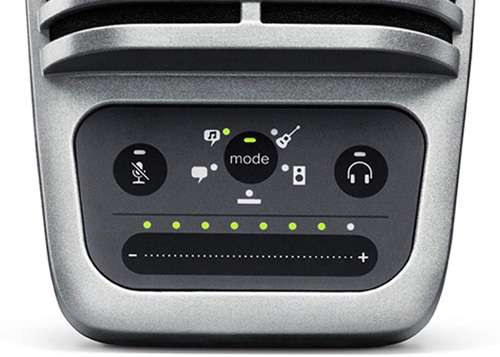
Choose from five DSP modes for the Shure MOTIV MV51: Speech, Singing, Flat, Acoustic Instrument, and Loud.
Soren: We have a dedicated audio processing group here, and we have two really talented guys who came in and sort of spearheaded that. Then I worked directly with them to sort of tune the DSP modes to how I think the customer wants them. We have some really smart, really dedicated audio processing guys to do that.
zZ: Were you involved with the development or testing with the ShurePlus MOTIV app?
Soren: Definitely — that was another thing that was very collaborative. As soon as we got working versions of the app, we wanted everyone on the team to use it as much as possible, because in software especially, there’s always bugs, no matter how long you work on something like that. It was a real collaborative team — everybody sort of dove in and found this little thing or that little thing. There’s another guy who has my same job named Thomas, who sort of spearheaded that. I worked directly with Thomas to come up with the high-level ideas on what the app needs to do. Obviously the MV88 has no buttons or controls or anything on it, so the app was going to be a required thing for the 88. We have recording now, and all sorts of cool features, and plenty more to come in the app. That was something that we did in-house here.
zZ: So that’s available free on the Apple App Store. Any plans for an Android version of the ShurePlus MOTIV app?
Soren: Droid only recently started supporting USB audio, so creating a “Droid version” wasn’t possible when we started the development of the MOTIV products. But now, actually, the MV5, the MV51 and MVi are all Droid-compatible since USB audio on Droid is now being supported by the latest operating system — which we’re excited about. And, the MVL lavalier mic is compatible with anything that has a standard TRRS jack.
“We wanted to make real Shure-quality professional tools, but make them for devices that everybody already has in their pocket.”
zZ: The MOTIV series is the first step into iOS Lightning microphones — is that right?
Soren: For us, definitely. There’s one or two other mics out there that offer Lightning direct connections, but we were right on that first wave. MOTIV products are definitely the first products that Shure’s done dealing with the Lightning connector.
zZ: Have customers been asking for iOS Lightning mics? Where did the idea come from?
Soren: We send lots of people to lots of tradeshows throughout the year, and every time we go, we’re seeing more and more iOS devices being implemented as professional tools. Obviously not just cell phones — there’s guys walking around doing video blogs with iPads, still using the built-in microphone. Everybody’s going to a concert like Pitchfork with an iPhone and shooting video with the built-in microphone. So it’s really us seeing an opportunity — we see this huge chunk of people just settling for really crappy audio because there’s not a really good professional tool out there. We wanted to make real Shure-quality professional tools, but make them for some devices that are really popular and that everybody already has in their pocket. iPads make awesome little demo studios. GarageBand’s a really powerful thing, actually. Being able to go to a concert with the MV88 — just the fact that it’s stereo over the omnidirectional that the built-in mic is, just makes the concert video experience way nicer. So it wasn’t like, “Hey, let’s do something Lightning.” But we wanted to do something specifically for phones, and as we started talking to Apple and looking into how best to do that, it became pretty obvious pretty quickly that Lightning was the only way to do it.
zZ: What are some tips and tricks you can give us for recording with the Shure MOTIV mics?
Soren: The MV5 and the MV51 are pretty straightforward — select your mode and go. The MV5 in particular, you click the button once and start talking into it, and you’re all set up. The 51 takes a little bit more tweaking because you have to set your gain by yourself, and it gives you a couple more options. The MV88 is a whole different ball of wax, because there’s tons of options there in the app. We’ve made hundreds of MV88 recordings now, and the biggest tip I can give people is “Just use your ears.” The MV88 microphone does an amazing job of capturing, but it’s not magic. If you go to a show at a huge concert hall like the Aragon, and you stand all the way in the back, and all you hear is giant bass and you don’t hear any detail, that’s what your MV88 is gonna hear. So try and get toward the front-of-house position where the guy mixing is, because that’s sort of the sweet spot in the room. The biggest tip I can give you is just to listen with your ears, and record from there. Placement is the most important thing with the MV88. Hopefully we made everything else easy with the app: one touch, press the DSP mode you’re looking for, and then you don’t have to worry about the technical details — you just capture it how you want to capture it.
“We made the MV88 for people to have a quick and really nice-sounding stereo microphone in their pocket.”
zZ: What are some ways that people have been using these microphones that you didn’t anticipate?
Soren: We’re seeing really top-end sound guys using them, anytime they need something quick — it’s such an easy workflow, and the audio is so darn good, that it’s so easy for a pro to just pull ’em out of his pocket and press record. There was a gentleman who reached out to us from Sweden — he’s the head AV guy for the Gothenburg Symphony Orchestra, who apparently have a great digital presence: they record and broadcast all their concerts; they have a really popular YouTube channel and Facebook page. They were going on tour to China to play in some famous concert hall with a famous conductor and a violin soloist, and the AV guy didn’t want to travel with his huge Decca tree orchestral rig. He heard about the MV88 and reached out to us, so we sent him one, and he made a great little YouTube video and sent some clips that are just awesome — just shot right there on his iPad. So they’ve been publishing content on a daily basis. He uses the MV88 for everything from capturing the orchestra performing in that gorgeous orchestra hall there, to interviews with players and day-to-day content; journal-entry type stuff. He just really appreciated the flexibility of it. We made the MV88 for people to have a quick and really nice-sounding stereo microphone in their pocket, and we’re just thrilled that someone that has bottomless resources like that was so drawn to it.
zZ: I have to say, one thing I really like about the app and the MV88 is the Raw Mid/Side mode. You know it’s a pro thing because it has raw middle/side!
Soren: Totally. We felt really strongly about making the DSP modes easy to use — especially with the 88. You press Loud mode, and it drops your gain all the way down, and puts on the compressor and the limiter, and EQs it, and sets your stereo width — it does 5 or 6 steps for you. But we didn’t want to abandon the pro user. There’s a lot of audio know-how in house here, so we really wanted to let it be just a professional tool where you don’t have to use the DSP. So we have the Flat mode in there, which is literally no compression, no EQ, no nothin’ — and the Raw Mid/Side mode. So you can really capture it unaffected, and if you’re looking to post-process it yourself, you can do both the sound signature as well as the actual stereo spread if you’re doing Raw Mid/Side. So that’ll be really fun to see how people use that. Mid/Side is such a powerful thing, but it’s kind of intimidating when you first learn about it — two mics have to be set up correctly, and then there are some steps that you have to take in post to get it to go. But hope that people will learn a lot about Mid/Side from this. Certainly the pros who know they want to do it themselves — or at least have the flexibility to do it themselves in a post environment — are going to use that.
zZ: See, I would pick Raw Middle/Side any day, because I’m like — “I don’t know if I want more sides or middle.” And Middle/Side lets you “fix it in post.”
Soren: It’s awesome to not have to worry about that.
zZ: Does the MV88 actually have two capsules — a cardioid capsule, and then a bidirectional capsule?
Soren: Absolutely. If you hold it up to the light without the windscreen on, you can kind of see it. But that’s exactly what it is: there’s a cardioid facing forward, and then a bidirectional right behind it. Another reason we really liked the mid/side configuration is it kept the microphone small, whereas if we did something like an X/Y, we’d have a much larger footprint. The middle/side mic is a lot easier to aim — trying to find the center of an X/Y pair can be tricky sometimes, and they tend to be sensitive, so if you miss just by a little bit, your whole image is sort of shifted one way, and your left is louder than your right. But because it’s mid/side, it’s a single point, and anybody can point a microphone at something.
Andres: Especially with the windscreen.
Soren: Especially with the windscreen on it, yeah. That’s a great point.
zZ: It’s a little easier than setting up a Decca tree, yes.
Soren: Absolutely!
zZ: So, what’s it like to work for one of the most influential companies in history?
Andres: For me, I’ve been here 10 years now, and one of the things that hit me — and I’m still pleasantly surprised by, frequently — is just the sheer amount of passion people have. Especially when you’re doing something unique like MOTIV, you constantly had people from elsewhere in the company just really curious about what the status is. They want to hear something; they want to use something; they want to really know what’s going on. And that passion, I think, goes through everything we have here, which makes it really, really great.
Soren: Even globally, when we get to meet the guys who work overseas in Asia and Europe — that passion is everywhere. We love coming to work; we love wearing a badge that says “Shure” on it; we love going to shows to represent it; we love the history here. It’s a big old family, and everybody loves being here. It makes a really awesome work environment. Not to be too cliché, but if you love what you do, and who you do it with, you never work a day in your life. That’s definitely here — people have huge stocks of vacation time piled up because everyone likes being here!
Andres: The other aspect of the passion is just how diverse it is, too. My background is in sound engineering, mostly; I’ve never really been a musician myself. But that’s not rare at all here. And there’s also so many different types of musicians and so many different genres that you kind of run the gamut, and you cover that whole spectrum, which is really great to see and hear.
Soren: As a product manager, it’s awesome to work with a team of engineers like Andres, who have either musical or sound engineering backgrounds. They’re not just designing black boxes and gray tubes that they don’t care about; they can put themselves into the shoes of who’s using it and understand why we’re making these choices, and why we’re choosing this feature over that. It’s awesome.
zZ: There’s a lot of excitement about the MOTIV series. But does anybody say, “Oh, these are so consumer-focused. Why are you doing these instead of a super-pro $1000 microphone?”
Soren: We haven’t gotten that at all, actually! People totally give it the benefit of the doubt. Especially when you pick it up — the MV51, the MVi, the MV88 — it legitimizes it. We’re a big name to be making these types of products, and we want people to know that they’re professional tools. They’re not just little plasticky USB things that’ll make noise so you can have fun in your basement. These went through the exact same engineering process as our world-class leading wireless systems do. This is a real Shure-engineered product; it gets tested like all the other ones. You can run an MV51 over with your car. We’re pretty unique in this space of build quality and audio quality, and the time we take to get to know the customer and the use cases. I can’t wait to see how the general public receives the MOTIV series, but we haven’t had any indication of that at all. People have always been super-impressed by them. Even if they come to the booth maybe with a furrowed brow, not quite giving it the benefit of the doubt, they always leave impressed and smiling.
See the Shure MOTIV series on zZounds
Photo credit: Shure Corporate Photography.

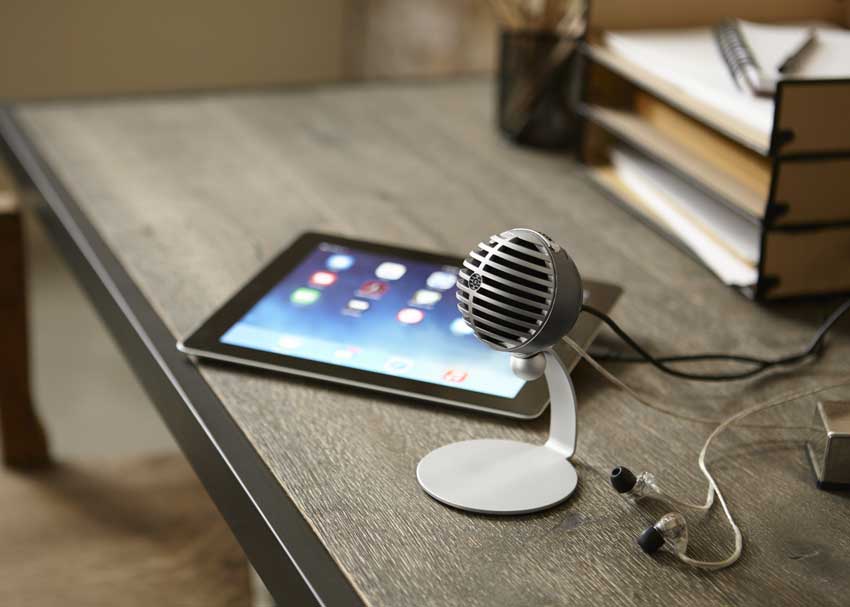
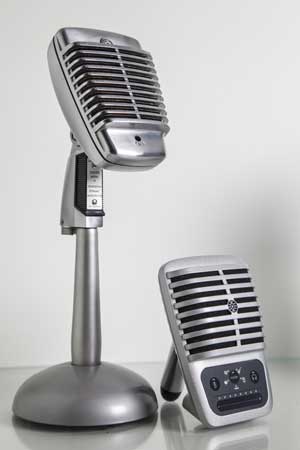
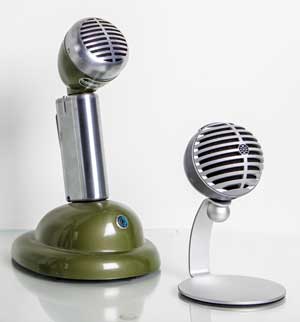
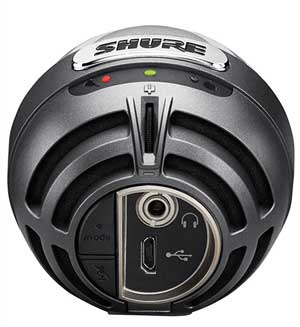
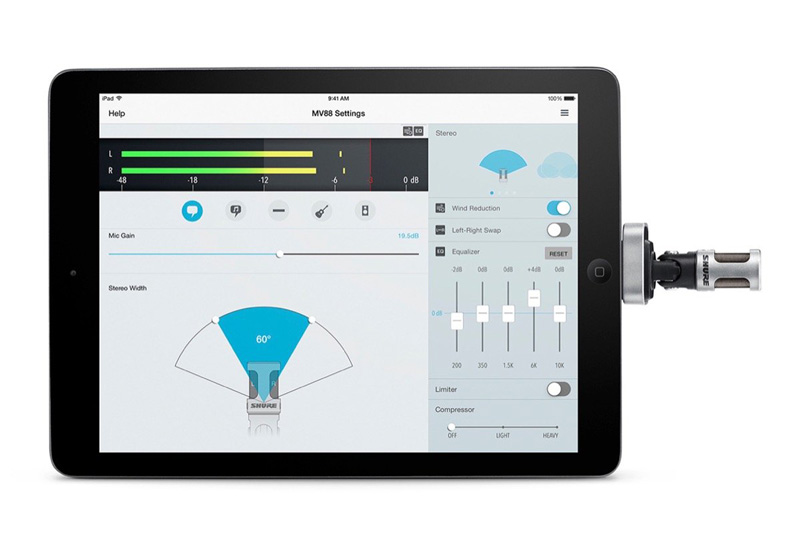


Leave a Reply